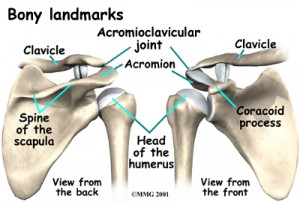WHY YOU SHOULD CARE ABOUT THORACIC MOBILITY
 By: Dr. Rachel Jakubowski
By: Dr. Rachel JakubowskiPhysical Therapist
SPECTRUM, Inc
Do you have low back pain, shoulder pain, or neck pain?
Do you want to improve your golf swing, overhead serve in volleyball, hitting power in baseball and softball, or throwing power/distance in baseball and football?
As a physical therapist, the thoracic spine is one of first areas I treat. Whenever you lift your arm overhead, throw a ball, swing a golf club, or even look up at a book on a high shelf, your thoracic spine is moving.

Try this: relax your upper back and shoulders and get really slouchy in your chair. Now try looking up at the ceiling. Then try lifting your arm overhead… Hard right? Now sit up nice and tall in your chair and perform the same two movements. Should be much easier, more comfortable, and you should be able to get more range of motion in your neck and shoulder. I know this is a very extreme example but imagine how much even a little bit of thoracic spine stiffness can affect how you get your arms overhead to spike a ball in volleyball or throw a baseball.
Common problems associated with poor thoracic mobility include shoulder impingement/pain, low back pain, and neck pain. There are other factors that can contribute to these same issues but, in this article, we are going to focus on the thoracic spine as the root of the problem. When the thoracic spine doesn’t move, your low back starts to pick up the slack. Instead of getting normal extension through your thoracic spine you end up hyperextending through your lumbar spine. This repetitive lumbar hyperextension leads to pinching posteriorly of the bones in your low back, thus resulting in pain. The same issues can happen at your neck.

When you lift your arm overhead and you cannot extend in the thoracic spine, what will typically happen is your humerus will jam up against the acromion (See picture below). Having this bone to bone contact overtime can lead to pain. This same issue can also lead to rotator cuff muscle microtears because the rotator cuff muscle sits right underneath the acromion, and the friction of the constant bone to bone contact can lead to fraying of the muscle underneath.

From a performance perspective in overhead athletes or overhead lifting (push press, push jerk, overhead squat), more force can be generated and more weight can be lifted when you have the range of motion to complete the movement. To properly engage your shoulder blade muscles and have your shoulder blade sit properly on the ribcage, you need full range of motion of the shoulder joint and thoracic spine. If not, like we mentioned before, your shoulder blades will sit forward on your ribcage (like with bad slouching posture) and your shoulder blade muscles won’t be able to engage properly. The better your shoulder blade muscle strength and stability are, the more power you can generate and the more weight you can lift overhead.
Imagine swinging a baseball bat if you can’t rotate your thoracic spine. With this limitation the force you can produce when you hit the ball will be considerably less as compared to being able to rotate your spine fully.
Here are some exercises you can do on your own to address this area of the body:
Foam Roll Thoracic Spine
Rib Roll
Supine or Seated Angel
You can perform this technique seated with your low back pressed flat into the wall as well. If lying on the ground is too easy, switch to seated against the wall.
Leave a Reply